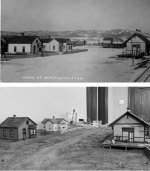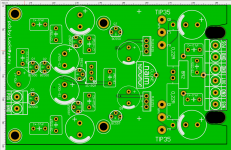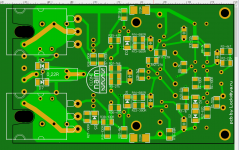Here's a train picture for Traderbam.
At the risk of being seriously OT...
The grass and scrub is really impressive, it's so difficult to get that sort of thing to scale. Buildings and staging look great.
Congrats. Always thought that with most layouts the surroundings take much more time and care than track and rollingstock...
How big is the layout? Of a specific region, area? Or just a figment of your imagination...
Yes, there is a big difference between "state of the art" audio design as taught to engineering students and Naim's legendary, somewhat unique and quirky approach to sound quality. The original demo model was an instant hit with marketing people of the day because it delivered more engagement and pleasure with audio than typical products of the 1970s that were designed largely on the premise that low THD and noise alone will result in the best sound quality. But honing those parameters alone did not work and assuredly still don't for music lovers, audiophiles and many young folk who haven't yet been coached in the dogmas of audio science.
Some manufacturers still seem to go to market with mediocre sound quality because they rely on engineering and in-house listening tests to define the performance and sound quality when the obvious buyer choices are going to be subjective - like comparing looks, sound quality, operating features of competitors products.
On the downside, people paid a lot more for Naim products than conventional designs but had to put up with some awful build compromises, unpopular connectors and crazy-expensive little power supply boxes and cables just to maintain backward-compatibility. It's a nice gesture to owners who have shelled out lots of money but stretching that concept out to decades was unwise, IMV. There were some other "howlers" left over from early days but experience and input from others along the way, eventually brought us to the "olive fascia" and "all-black box" eras when many of the fiddly little power supply boxes were put to rest and preamps contained all that was really necessary in one box
Some manufacturers still seem to go to market with mediocre sound quality because they rely on engineering and in-house listening tests to define the performance and sound quality when the obvious buyer choices are going to be subjective - like comparing looks, sound quality, operating features of competitors products.
On the downside, people paid a lot more for Naim products than conventional designs but had to put up with some awful build compromises, unpopular connectors and crazy-expensive little power supply boxes and cables just to maintain backward-compatibility. It's a nice gesture to owners who have shelled out lots of money but stretching that concept out to decades was unwise, IMV. There were some other "howlers" left over from early days but experience and input from others along the way, eventually brought us to the "olive fascia" and "all-black box" eras when many of the fiddly little power supply boxes were put to rest and preamps contained all that was really necessary in one box
Last edited:
The towns modelled will be Silica, Jefferson, Kokomo and Sargents, all in Colorado. Most buildings are historically accurate except for Kokomo (which was razed in the 50's). The layout is a 'G' shape, approx 17' x 15'. HOn3 scale.




I withdraw my sarcy quip! That’s masterful. Your attention to detail is impressive.Here's a train picture for Traderbam.
the sound of Naim is highly overrated. Perhaps then it was some kind of breakthrough, but now in stock, without some modifications, I could not listen to it. Namely, i replaced ceramics with wima film, tantalum with electrolytes by Elna silmik2 and raised the quiescent current of the transistor to 100mA
Last edited:
Member
Joined 2009
Paid Member
If you aren't looking for the Naim sound (whatever that is) then there's really not reason to build a clone when there are so many other options available.
I found my clone was a bit too harsh sounding on my PMC floorstanders, which tend to be bright. It will never be my main amplifier but I like having it in the stable, it has a texture to the sound that is certainly not 'clean and neutral' (published reviews describe it well) plus I enjoyed engineering it to provide a more professional thermal management approach. I'm going to reduce the supply voltage to it at some point to bring it closer to stock.
I found my clone was a bit too harsh sounding on my PMC floorstanders, which tend to be bright. It will never be my main amplifier but I like having it in the stable, it has a texture to the sound that is certainly not 'clean and neutral' (published reviews describe it well) plus I enjoyed engineering it to provide a more professional thermal management approach. I'm going to reduce the supply voltage to it at some point to bring it closer to stock.
Last edited:
The towns modelled will be Silica, Jefferson, Kokomo and Sargents, all in Colorado. Most buildings are historically accurate except for Kokomo (which was razed in the 50's). The layout is a 'G' shape, approx 17' x 15'. HOn3 scale.
Whoa! I am impressed. Serious stuff.
I once passed through near this area on Amtrak, and later by bus.
Last edited:
Looking for a little advice. I built a couple boards with spare parts I scrounged together, and used the stock schematic with the protection circuit intact. One functions perfect, the other has no gain. Both bias fine and have very low DC on the outputs but one just doesn't make gain in the VAS. All DC voltages are the same on both boards, the AC is the same in the LTP, and differs when it gets to the VAS where one simply fails. I thought it was a malfunctioning protection circuit that was dumping the voltage but i removed the two protection transistors and the problem remained. Should i replace the ZTX's? even though the DC matching implies they are functioning? Any guru have some advice?
Quote:
Ok! I have used 2N5551 and changed with ZTX108, then bias doubled. If they are similar transistors, how the bias doubled?
I'm not sure about what orjinal Q5 is ZTX108 or ZTX384? Or really doesn't matter 2N5551, BC550, BC239, 2SD786 or some other similar transistors?
Ok! I have used 2N5551 and changed with ZTX108, then bias doubled. If they are similar transistors, how the bias doubled?
A pair of 2N5551s could easily be different enough to double the bias, and that's the same transistor. That's why there's a pot to adjust the bias.
I'm not sure about what orjinal Q5 is ZTX108 or ZTX384? Or really doesn't matter 2N5551, BC550, BC239, 2SD786 or some other similar transistors?
For building Nap 250 clone, what is the recommended transformer and capacitance ratings?
35v 500A toroid and 30,000uf is enough?
Thanks
500 amps should be enough.
Has anyone measured the average power an average speaker consumes? I did some measurements a while back and estimated it’s roughly 1A at very high music volume per channel. So a couple of amps on average at somewhere between zero and 40V. Let’s 50W average demand on the power supply.
So a 500W transformer is overkill for supplying the average power but is related to the way the power is extracted from the transformer in short bursts via the rectifiers. So I reckon you could use a much smaller transformer if you were able to design a circuit that extracts the power over a longer time period.
So a 500W transformer is overkill for supplying the average power but is related to the way the power is extracted from the transformer in short bursts via the rectifiers. So I reckon you could use a much smaller transformer if you were able to design a circuit that extracts the power over a longer time period.
Yes of course you can do this it will even give you power factor correction For the the last 20 years or so I have been involved with UPS units varying from a few hundred watts to a a few megawatts ! This being said the UPS technology is far more difficult/costly to implement than a transformer /rectifier and a few caps
Trev
Trev
- Home
- Amplifiers
- Solid State
- NAP250 clone


